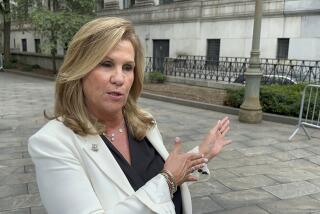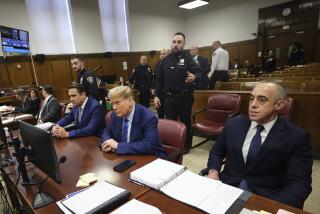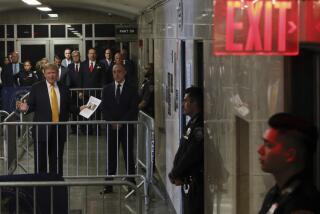Prosecutors Rest in Trial of Trade Center Blast Suspects : Terrorism: Case against the four defendants is circumstantial. The defense is expected to argue that the burden of proof has not been met.
- Share via
NEW YORK — After 18 weeks of testimony by more than 200 witnesses, government prosecutors in the World Trade Center bombing trial wrapped up their presentation Tuesday--capping a case that has been remarkable for its detail as well as its shortcomings.
Prosecutors rested their case against the four defendants after two final days of testimony by David Williams, the FBI’s primary investigator of the terrorist attack last Feb. 26. Williams gave an overview of the circumstantial evidence.
Defense attorneys are expected to start presenting evidence later this week. It was considered unlikely that any of the defendants would choose to testify.
Defense sources said they expect their presentation to take a few days at most. Asserting that prosecutors had failed to meet their burden of proof, several defense lawyers said they would be content to argue to jurors that reasonable doubts exist about the guilt of their clients.
The prosecution has built its case entirely on indirect evidence against the four alleged “foot soldiers” accused of constructing the bomb that devastated the World Trade Center, killing six people, injuring more than 1,000 and disabling for a month one of the world’s best known landmarks.
Contrary to many celebrated trials, the government had no eyewitness to place the defendants at the scene, no former associate to testify about their movements. Prosecutors had offered concessions to at least two of the four defendants in unsuccessful attempts to persuade them to testify against the others.
Instead, chief prosecutor Gilmore Childers presented one element of circumstantial evidence after another to try to show that the defendants rented an apartment and a storage shed in New Jersey to mix chemicals for the bomb and had access to joint bank accounts to finance their endeavors.
Prosecutors also asserted that the conspirators leased a Ryder van in Jersey City to take the 1,200-pound explosive device into the trade center’s underground garage.
Defense attorneys hope to spotlight weaknesses in the government’s case.
For example, a parade of experts over several weeks testified about the destructive force of the bomb and about different types of chemical residues found in the defendants’ rented apartment and a nearby storage locker.
But in recent days, when an FBI analyst was called to the witness stand to tie the case together, he was unable to pinpoint the type of bomb used. He said chemical tests were inconclusive in showing whether components of the bomb matched residues found in quarters rented by the defendants.
One of the most discouraging moments for prosecutors occurred when a Jersey City gas station attendant was called to the stand to identify two defendants--Mohammed A. Salameh and Mahmud Abouhalima--who he said had gassed up their yellow rental van before the blast.
After accurately describing the physical features of Salameh and Abouhalima, the witness, Willie Hernandez Moosh, was asked to identify them in the courtroom. He pointed to two members of the jury, leaving the courtroom rocking in laughter.
Abouhalima, who fled to Egypt after the bombing but was seized there and returned, has been linked to Salameh through records of eight telephone calls and by two people who said they saw a man of his description helping Salameh carry large drums from his apartment. But neither witness was able to identify Abouhalima in the courtroom.
An FBI search of Abouhalima’s New Jersey apartment found a pair of shoes stained with sulfuric acid of the type used in explosives.
Witnesses said a third defendant, Nidal Ayyad--who held joint bank accounts with Salameh--ordered chemicals of the type investigators believe were used in the trade center bomb, purportedly for a second bomb. Again, the evidence was circumstantial.
Potentially more damaging has been evidence that Ayyad sent a letter to a New York newspaper threatening further attacks unless the United States ended all military aid to Israel. He was linked to the letter through computer discs found in his office and a DNA test from saliva taken from the envelope.
But Ayyad’s attorney, Atiq Ahmed, showed on cross-examination of a government witness that the DNA traces could have applied to a small fraction of the Arab American population in the United States.
Mohammad Ahmad Ajaj, the final defendant, was in jail on a passport violation at the time of the bombing. The government’s theory is that Ajaj provided bomb-making manuals to the conspirators as early as September, 1992, when he entered the country from Pakistan. The manuals were seized at New York’s John F. Kennedy Airport, along with other materials in his possession, including a video showing how terrorists blow up buildings.
If convicted as charged in the 13-count indictment, the defendants face a maximum punishment of life imprisonment.
More to Read
Sign up for Essential California
The most important California stories and recommendations in your inbox every morning.
You may occasionally receive promotional content from the Los Angeles Times.













